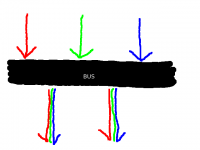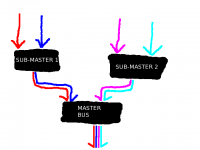< User:Crantila | FSC
These terms are used in many different audio contexts. Understanding them is important to knowing how to operate audio equipment in general, whether computer-based or not.
Address: User:Crantila/FSC/Audio_Vocabulary
MIDI Sequencer
A sequencer is a device or software application which produces signals that a synthesizer to turns into sound. Sequencers also allow the editing and arrangement of these signals into a musical composition. The two MIDI-focussed DAWs in the Musicians' Guide, Qtractor and Rosegarden, are well-suited to serve as MIDI sequencers. Furthermore, all three DAWs use MIDI instructions to perform automation.
Busses, Master Bus, and Sub-master Bus
An audio bus is used to send an audio signal from one place to another. Like a highway is used to collect all sorts of automobiles going in the same general direction, an audio bus is collects all sorts of signals going in the same direction (usually into or out of the DAW, but sometimes between parts of the DAW). Unlike a highway, however, once audio enters a bus, it cannot be separated.
All audio being routed out of a program usually passes through the master bus. The master bus collects and consolidates all audio and MIDI tracks, allowing for final level adjustments and for simpler mastering. The primary purpose of the master bus is to mix all of the tracks into two channels.
A sub-master bus collects audio signals before they're inputted to the master bus. Using a sub-master bus is optional, and it allows you to subject more than one track to the same adjustment, without affecting all the tracks. A sub-master bus is often simply referred to as a bus.
Not Done Yet
Level (Loudness)
!! INCOMPLETE !!
The level of a track, region, or session is experienced by listeners as its "volume." In professional audio situations, levels are measured in decibels (dB), but represented in a manner that is not at first obvious: 0 dB is the absolute maxmimum level desired. Although it is possible to reproduce higher levels, they may become distorted (REALLY??)
Check:
- "Level Practices"
- this, and
- this
- consider adding a section about "jkmeter," but... well... consider it
- maybe this, too
Panning and Balance
!! tricky section !!
!! diagram possibly useful !!
Panning is the process of adjusting how much of a track's sound level is sent to each output channel (see "Multichannel Audio"). Assuming a stereophonic setup, you could cause both of the track's channels to be routed to only one speaker. When a track is set for "centre" panning, all of the left channel audio is heard from the "left" speaker, and all of the right channel audio is heard from the "right" speaker. As you adjust towards "left" panning, all of the left channel audio remains heard through the "left" speaker, as well as an increasing portion of the right channel audio. At the same time, the level of the right channel audio is lowered, so that the level of the right channel audio heard from the "left" speaker plus that heard from the "right" speaker is equal to the level of the right channel when the track is set to "centre" panning. The opposite effect happens when a track is adjusted towards "right" panning.
Balance seems to have a similar effect, but it is not quite the same as panning. The two terms are sometimes confused on audio equipment and in popular usage. As you adjust the balance towards the "left" setting, the level of the right channel is reduced, until it can no longer be heard. By contrast, as you adjust the panning towards the "left" setting, the level of the right channel is reduced, but the right channel's audio can still be heard in the left channel. In effect, balance allows you to "turn off" a channel of audio, or to compensate for non-equidistant speakers. Panning, on the other hand, allows you to effectively combine two audio tracks into one, or to partially combine the tracks, so that the audio signal seems to appear somewhere closer to the centre than before adjustment.
Synchronization
Synchronization is exactly what it sounds like - synchronizing the operation of multiple tools. Most often this is used to synchronize movement of the transport, and to control automation across applications. This sort of synchronization is typically achieved with MIDI channels that are not used directly for synthesis.
Time and Time-Shifting
Time in a DAW is measured from 0, marking the start of playback, to an arbitrary place which marks the end of playback. There are many different ways to measure musical time, and most DAWs allow the user to work in whichever happens to suit them best. The purpose for all methods of measuring time is to precisely indicated when an event (whether audio or MIDI) should begin and end.
- Bars (Measures) and Beats: Usually used for MIDI work.
- Minutes and Seconds: Also includes more precise levels; usually used for audio.
- SMPTE Timecode: Invented for high-precision coordination of audio and video, but can be used with audio alone.
- Samples: Relating directly to the format of the underlying audio file, a sample is the shortest possible length of time in an audio file. See THE DIGITAL AUDIO SECTION for more information.
When a region is time-shifted, the time it is triggered in the DAW is changed. This can be used to "align" musical events that are supposed to be perceived as happening together.
Time is represented in the main DAW interface window as progressing horizontally, where the leftmost point to which the window scrolls is considered to be 0.
Multichannel Audio
?? is this too political, or appropriate ??
Each channel of audio is independent, and is intended to be played by one speaker. Audio was originally recorded with only one channel, producing "monophonic," or "mono" recordings. Beginning in the 1950s, stereophonic recordings gradually replaced monophonic ones. Most sound recordings available today have at least two channels, making them stereophonic. There is a move now towards five- and seven-channel audio recordings, esepcially for movies, which helps to build a feeling of the sound surrounding the listener (thus "surround sound"). Although Audio CDs and headphones used for MP3 players - plus the fact that humans have only two ears - seem to be slowing the trend for recorded music, both Super Audio CDs and DVD Audio discs offer the capability for more than two channels. There are other factors holding back these formats, the most prominent of which is obstacles posed by copy-protection measures put in place by record labels.
Routing and Multiplexing
!! "Routing audio is... " !!
!! diagram required !!
Routing audio is achieved on Linux primarily by using the JACK Audio Connection Kit, and the QjackCtl graphical front-end. JACK-aware applications (and PulseAudio, if so configured) provide both inputs and output for audio, assigning different names, and allowing different tasks. Ardour and Qtractor make quite extensive use of JACK - Ardour even for internal connections. This allows for maximum flexibility and creative solutions to otherwise-complex problems.
Mutltiplexing is a related process, which involves routing audio from one output to many inputs or vice-versa. It is also used to refer to a DAW's capability to simultaneously produce and record audio or MIDI signals. With JACK, multiplexing is as easily achieved as basic audio routing. It may require special attention to ensure that all inputs and outputs are properly connected.


